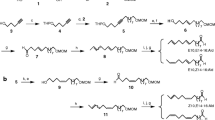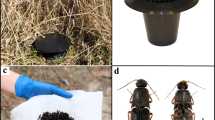Abstract
Two sex pheromone components, 3(Z),6(Z),9(Z)-nonadecatriene (3Z,6Z,9Z-19 ∶ H), and 3(Z),6(Z),9(Z)-eicosatriene (3Z,6Z,9Z-20∶ H), have been positively identified, and a third component, 6(Z),9(Z)-nonadecadiene (6(Z),9(Z)-19 ∶ H) has been tentatively identified from abdominal tip extracts of female spring cankerworm moths,Paleacrita vernata Peck (Lepidoptera∶ Geometridae). The pheromone components were identified by a combination of gas chromatography, electroantennography, mass spectrometry, chemical tests, comparison with standards, and field testing. Only 3Z,6Z,9Z-20 ∶ H exhibited significant attractant activity when tested alone, and it was potentiated by the other two components. The attractive blend was an 8∶2∶1 ratio of 3Z,6Z,9Z-20∶H/3Z,6Z,9Z-19∶H/6Z,9Z-19∶H. However, the two-component blend of 3Z,6Z,9Z-20 ∶ H and 6Z,9Z-19 ∶ H (8∶1 ratio) was as attractive as the three-component blend in further field tests. A series of related compounds, the diene monoepoxides available from epoxidation of C19 and C20 3Z,6Z,9Z-trienes, some of which have been found in the pheromone blends of other moth species, were tested as behavioral antagonists. The attraction of male moths to synthetic lures was suppressed by the addition of 6Z,9Z-cis-3,4-epoxy-nonadecadiene to the lures. Additional experiments were performed to determine the effects of lure dosage, trap height, and trap design on the numbers of male moths captured.
Similar content being viewed by others
References
Arn, H.,Tóth, M., andPriesner, E. 1986. List of sex pheromones of Lepidoptera and related attractants. OILB-SROP/IOBC-WRPS, Secrétariat General, 149 Rue de Bercy, F-75595 Paris cedex 12; ISBN 92-9067-002-9.
Becker, P., Kimmel, T., Cyjon, R., Moore, I., Wysoki, M., Bestmann, H.J., Platz, H., Roth, K., andVostrowsky, O. 1983. (3Z,6Z,9Z)-3,6,9-nonadecatriene-a component of the sex pheromonal system of the giant looper,Boarmia (Ascotis) selenaria Schiffermüller (Lepidoptera: Noctuidae).Tetrahedron Lett. 24:5505–5508.
Becker, D., Moore, I., Cyjon, R., Kimmel, T., Cosse, A., andWysoki, M. 1987. The active component in the sex pheromone of the giant looper,Boarmia selenaria.Phytoparasitica 15:160.
Bell, T.W., andMeinwald, J. 1986. Pheromones of two arctiid moths (Creatonotos transiens andC. gangis): Chiral components from both sexes and achiral female components.J. Chem. Ecol. 12:385.
Bestmann, H.J., Brosche, T., Koschatzky, K.H., Michaelis, K., Platz, H., Roth, K., Suss, J., Vostrowsky, O., andKnauf, W. 1982. Pheromone-XLII. 1,3,6,9-Nonadecatetraen, das Sexualpheromon des FrostspannersOperophtera brumata (Geometridae).Tetrahedron Lett. 23:4007–4010.
Bogenschütz, H., Knauf, W., Tröger, E.J., Bestmann, H.J., andVostrowsky, O. 1985. Pheromone 49: Freilandfänge von Geometriden-Männchen mit C9-Polyenen in Kiefernbeständen.Z. Angew. Entomol. 100:349–354.
Buser, H.R., Guerin, P.M., Tóth, M., Szöcs, G., Schmid, A., Francke, W., andArn, H. 1985. (Z,Z)-6,9-nonadecadien-3-one and (Z,Z,Z)-3,6,9-nonadecatriene: Identification and synthesis of sex pheromone components ofPeribatodes rhomboidaria.Tetrahedron Lett. 26:403–406.
Descoins, C., andFrérot, B. 1984. XVIIth International Symposium of Entomology, Hamburg, August 20–26, 1984.
Descoins, C., Lalanne-Cassou, B., Malosse, C., andMilat, M.-L. 1986. Analyse de la phéromone sexuelle émise par la femelle vierge deMocis latipes (Guenée) (Noctuidae, Catocalinae de Guadeloupe, Antilles Françaises).C.R. Acad. Sci. Paris, t. 302, Ser. III, 13:509–512.
Duncan, D.B. 1955. Multiple range and multiple F tests.Biometrics 11:1–41.
Furniss, R.L., andCarolin, V.M. 1977. Western Forest Insects. USDA Misc. Publication No 1339, U.S. Government Printing Office, Washington, D.C. pp. 214.
Heath, R.R., Tumlinson, J.H., Leppla, N.C., McLaughlin, J.R., Dueben, B., Dundulis, E., andGuy, R.H. 1983. Identification of a sex pheromone produced by female velvetbean caterpillar moth.J. Chem. Ecol. 9:645–656.
Hill, A.S. andRoelofs, W.L. 1981. Sex pheromone of the saltmarsh caterpillar moth,Estigmene acrea.J. Chem. Ecol. 7:655–668.
Hill, A.S., Kovalev, B.G., Nikolaeva, L.N., andRoelofs, W.L. 1982. Sex pheromone of the fall webworm moth,Hyphatrea cunea.J. Chem. Ecol. 8:383–396.
Ives, W.G.H., andWong, H.R. 1988. Tree and Shrub Insects of the Prairie Provinces. Information Report NOR-X-292, Northern Forestry Center, Canadian Forest Service, Edmonton, Alberta.
Jain, S.C., Dussourd, D.E., Connor, W.E., Eisner, T., Guerrero, A., andMeinwald, J. 1983. Polyene pheromone components from an arctiid moth (Vtethesa ornatrix): Characterization and synthesis.J. Org. Chem. 48:2266–2270.
Landolt, P.J., Heath, R.R., andLeppla, N.C. 1986. (Z,Z,Z)-3,6,9-Eicosatriene and (Z,Z,Z)-3,6,9-heneicosatriene as sex pheromone components of a grass looper,Mocis disseverans. (Lepidoptera: Noctuidae).Environ. Entomol. 15:1272–1274.
Linn, C.E., andRoelofs, W.L. 1989. Response specificity of male moths to multicomponent pheromones.Chem. Senses 14:421–437.
McDonough, L.M., Bailey, J.B., Hoffman, M.P., Leonhardt, B.A., Brown, D.F., Smithhis-Ler, C.L., andOlsen, K. 1986.Sabulodes caberata Guenée (Lepidoptera: Geometridae). Components of its sex pheromone gland.J. Chem. Ecol. 12: 2107–2116.
McLaughlin, J.R., andHeath, R.R. 1989. Field trapping and observations of male velvetbean caterpillar moths and trapping ofMocis spp. (Lepidoptera: Noctuidae: Catocalinae) with calibrated formulations of sex pheromone.Environ. Entomol. 18:933–938.
Millar, J.G., Underhill, E.W., Giblin, M., andBarton, D. 1987. Sex pheromone components of three species of Semiothisa (Geometridae), (Z,Z,Z)-3,6,9-heptadecatriene and two monoepoxydiene analogs.J. Chem. Ecol. 13:1371–1383.
Millar, J.G., Giblin, M., Barton, D., andUnderhill, E.W. 1990a. 3Z,6Z,9Z-Nonadecatriene and enantiomers of 3Z,9Z-ri. s-6,7-epoxy-nonadecadiene as sex attractants for two geometrid and one noctuid moth species.J. Chem. Ecol. 16:2153–2166.
Millar, J.G., Giblin, M., Barton, D., andUnderhill, E.W. 1990b. 3Z,6Z,9Z-Trienes and unsaturated epoxides as sex attractants for geometrid moths.J. Chem. Ecol. 16:2307–2316.
Millar, J.G., Giblin, M., Barton, D., Morrison, A., andUnderhill, E.W. 1990c. Synthesis and field testing of enantiomers of 6Z,9Z-cis-3,4-epoxydienes as sex attractants for geometrid moths. Interactions of enantiomers and regioisomers.J. Chem. Ecol. 16:2317–2339.
Mitchell, E.R., andHeath, R.R. 1986. Pheromone trapping system for the velvetbean caterpillar (Lepidoptera: Noctuidae).J. Econ. Entomol. 79:289–292.
Packard, A.S. 1876. A Monograph of the Geometrid Moths or Phalaenidae of the United States. U.S. Government Printing Office, Washington, D.C. pp. 404–405.
Palaniswamy, P., Underhill, E.W., Steck, W.F., andChisholm, M.D. 1983. Responses of the red-banded cutwormEuxoa ochrogaster (Lepidoptera: Noctuidae) to sex pheromone components in a flight tunnel.Environ. Entomol. 12:748–752.
Palaniswamy, P., Underhill, E.W., Gillott, C.E., andWong, J.W. 1986. Synthetic sex pheromone components disrupt orientation, but not mating in the fall cankerworm,Alsophila pometaria (Lepidoptera: Noctuidae).Environ. Entomol. 15:943–950.
Roelofs, W.L., Hill, A.S., Linn, C.E., Meinwald, J., Jain, S.C., Herbert, H.J., andSmith, R.F. 1982. Sex pheromone of the winter moth, a geometrid with unusually low temperature precopulatory response.Science 217:657–659.
Sonnet, P.E. 1974. A practical synthesis of the sex pheromone of the pink bollworm.J. Org. Chem. 39:3793–3794.
Szöcs, G., Tóth, M., Bestmann, H.J., andVostrowsky, O. 1984. A two-component sex attractant for males of the geometrid mothAlsophila quadripunctata.Entomol. Exp. Appl. 36:287–291.
Szöcs, G., Tóth, M., Bestmann, H.J., Vostrowsky, O., Heath, R.R., andTumlinson, J.T. 1987. Polyenic hydrocarbons as sex attractants for geometrids and amatids (Lepidoptera) found by field screening in Hungary.Z. Naturforsch. 42c:165–168.
Tóth, M., Buser, H.R., Pena, A., Arn, H., Mori, K., Takeuchi, T., Nikolaeva, L.N., andKovalev, B.G. 1989. Identification of (3Z,6Z)-1,3,6,9,10-epoxyheneicosatriene and (3Z,6Z)-1,3,6,9,10-epoxyeicosatriene in the sex pheromone ofHyphantrea cunea.Tetrahedron Lett. 30:3405–3408.
Underbill, E.W., Palaniswamy, P., Abrams, S.R., Bailey, B.K., Steck, W.F., andChish-Olm, M.D. 1983. Triunsaturated hydrocarbons, sex pheromone components ofCaenurgina erechtea.J. Chem. Ecol. 9:1413–1423.
Underhill, E.W., Millar, J.G., Ring, R.A., Wong, J.W., Barton, D., andGiblin, M. 1987. Use of a sex attractant and an inhibitor for monitoring winter moth and Bruce spanworm populations.J. Chem. Ecol. 13:1319–1329.
Wong, J.W., Palaniswamy, P., Underhill, E.W., Steck, W.F., andChisholm, M.D. 1984. Novel sex pheromone components for the fall cankerworm moth,Alsophila pometaria.J. Chem. Ecol. 10:463–473.
Wong, J.W., Underhill, E.W., Mackenzie, S.L., andChisholm, M.D. 1985. Sex attractants for geometrid and noctuid moths. Field trapping and electroantennographic responses to triene hydrocarbons and monoepoxydiene derivatives.J. Chem. Ecol. 11:727–756.
Young, B.P. 1918. Ecological notes on the spring cankerworm (Paleacrita vernata, Peck).Can. Entomol 50:267–277.
Author information
Authors and Affiliations
Additional information
Issued as NRCC 30711.
Rights and permissions
About this article
Cite this article
Millar, J.G., Giblin, M., Barton, D. et al. Identification and field testing of female-produced sex pheromone components of the spring cankerworm,Paleacrita vernata Peck (Lepidoptera: Geometridae). J Chem Ecol 16, 3393–3409 (1990). https://doi.org/10.1007/BF00982106
Received:
Accepted:
Issue Date:
DOI: https://doi.org/10.1007/BF00982106




